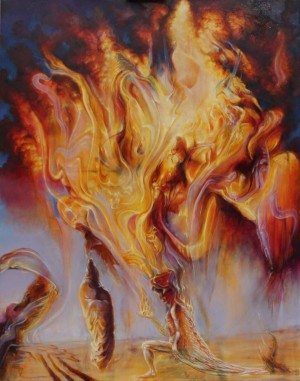I can’t say definitely that I’m there yet. As I sit on my comfy studio sofa (many thanks Lia!), I contemplate the day’s work. There is something starting to take shape, a tantalising more complete definition. Extend this here, darken that there, bring this colour in there and viola, there is the final painting. Ah, but some hours, perhaps days or even a week or two to go yet.
“When do I know when a painting is finished?”, I’ve often been asked. It might seem like a silly question, but often the way I work, there is no preliminary sketch or reference materials that I’m working from. It all comes out of my imagination and what is already there on the canvas waiting to be discovered. It is certainly not a new way to work. Even many non artists have laid on the grass and gazed at the clouds in the sky and imagined animals, faces or whatever. As a boy, I used to do it a lot with friends. We all took delight in trying to identify the visual fantasy of the other. It was sometimes very surprising how differently some one else saw the same thing. I still take pleasure in this when people discover something in my own work that I haven’t seen.
Artistically, I’m not alone in this method of visual inspiration. Everybody is familiar with the results of Dalí’s paranoic critical method, whereby one thing becomes another if you look at it in a different way. Even Leonardo Da Vinci was fond of the day dreamer’s gaze, or the thousand mile stare.
“It is in my opinion not useless if you pause in the realisation of pictorial forms and look at the spots on the wall, at the ashes of the hearth, at the clouds, or in the gutter: on careful observation, you will make wonderful discoveries there, which the genius of the painter can turn to good account in the composition of human and animal battles, landscapes, monsters, devils and other fantastic things which you can use to your advantage. These confused things awaken the genius to new inventions, although one must have learnt well how to do all the parts, especially the limbs of the animals and the forms of the landscape, its plants, and its stones.”
From Leonardo Da Vinci’s treatise on painting.
So here I am staring at my painting, filling in the gaps, or rather, it is filling in the gaps for me. But then I come back to myself, sitting on the couch, taking a deep breath I quit my repose and walk to the palette and brushes. Now its time to fill the gaps with a brush and paint.


Leave a Reply
You must be logged in to post a comment.